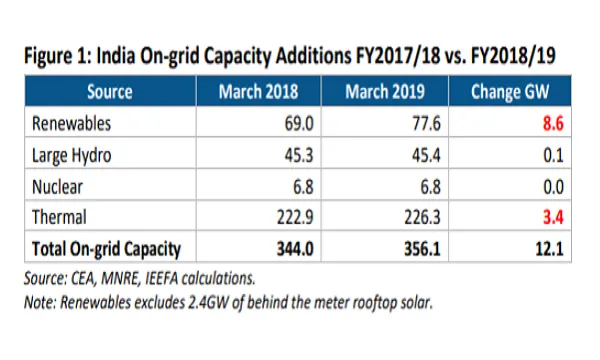
India added 12GW of new power capacity in FY2018/2019
New on-grid capacity additions in renewable energy stood at 8.6GW.
FY2018/2019 was a sluggish year for both the thermal as well as renewable sectors in India in terms of increased generation capacity, with only 12GW of net new power generation capacity added compared to an average of 22GW added between FY2016/2017 and 17GW in FY2017/2018, according to the Institute of Energy Economics and Financial Analysis (IEEFA).
As of March 2019, total on-grid capacity stood at 356.1GW from 2018’s 344GW.
India reportedly introduced 5.8GW of new coal-fired capacity, but shuttered 2.4GW of end-of-life thermal power plants during the year, resulting in net new thermal capacity adds of just 3.4GW. This is the lowest level of thermal coal power plant net adds in a decade.
Meanwhile, new on-grid capacity additions in renewable energy stood at 8.6GW, comprising 6.5GW of solar, 1.6GW of wind and 0.5GW from other sources, for the financial year ending in March 2019, representing a 40% drop from the peak renewable energy installs achieved in 2016/2017.
Also read: Solar to contribute the most to India's capacity expansion in 2020: analysts
That said, IEEFA noted that India’s electricity sector transition is still on track despite a weak FY2018/2019, with projects renewable additions through 2021/2022 based on auction and tender activities during the past 18 months.
According to co-author and IEEFA research associate Kashish Shah, the continued decline in thermal capacity additions was foreseeable given the ongoing financial distress of the thermal power sector and the loss of competitiveness compared with domestic renewable energy.
“Against this, the slowdown in renewable capacity additions at half the government’s targeted run-rate contradicts expectations,” he noted.
IEEFA also underscored that policy uncertainties, as well as a lack of grid infrastructure, were some of the key reasons for below-expected renewable capacity installations in FY2018/2019.
Despite the evident chaos in incomplete installations, India exited the year with 22.5GW of renewable capacity auctions awarded but yet to be built, and another 37GW under various stages of tendering and bidding.

Given the existing trajectory of wind and solar as well as other renewable sources of biomass and run-of-river (RoR), IEEFA forecasts India will reach 143.8GW renewable energy capacity by FY2021/2022, which is not far from the country’s aspirational 175GW target set back in 2015. This places India on track for a run-rate that will exceed its 275GW target in 2027.
Additionally, IEEFA noted that it expects another near-flat year for utility-scale solar with 7-8GW commissioned by March 2020, owing to import restrictions on solar modules for two years. In spite of this, 9GW of rooftop solar could be installed in the coming three years given the 68% growth rate in annual installs during calendar year 2018.
“There are challenges which could hinder acceleration of renewable energy capacity. The government of India must anticipate these challenges and plan to mitigate the risks as soon as possible,” Shah added.
IEEFA further outlined some of the challenges of grid expansion, such as ‘time-of-day’ pricing policies, land allocation issues, and setting fair upper caps on auction tariffs.
According to Tim Buckley, co-author of the briefing note and IEEFA’s director of energy finance studies, FY2018/2019 was a ‘blip’ for the Indian renewable energy industry. He expressed confidence that the long-term technology and price-based fundamentals of renewable energy will continue their upward trajectory.
Also read: Tata Power to raise renewables' share in new capacity additions to 70%
“India’s coal-fired capacity expansion has already declined to just 3-4GW of annual net additions, down 80% on installation activity from just three years ago. Ongoing reliance on domestic coal-fired power is a ‘necessary evil’ over the medium term to keep the lights on in a giant economy that is targeting sustained 7-8% annual gross domestic product (GDP) growth and further electrification,” Buckley explained.
India’s growing annual oil import bill is another important reason for supporting prime minister Narendra Modi’s solar ambitions. Short-term missteps are said to be getting in the way at a time when India is considering an even more ambitious acceleration of renewable energy deployments to 500GW by 2028, requiring a $500b investment in generation and another $250b in grid expansion and modernisation.
IEEFA also deemed ‘necessary’ the successful resolution of some of the 96GW of proposed new coal-fired power plant capacity that is currently stuck in the planning, approval and construction phases, in order to facilitate the retirement of 40-50GW of approaching end-of-life, highly polluting thermal power plants.



















 Advertise
Advertise







